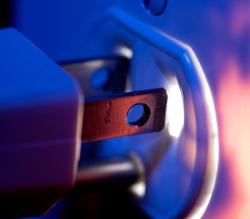
To mitigate an under voltage, the voltage regulator must get extra current from somewhere. If the under voltage condition exists because of ampacity problems in the branch circuit or facility electrical distribution, a voltage regulator will provide little benefit and may actually worsen circumstances by adding additional load to the circuit. Always remember that a voltage regulator is not some type of electrical “perpetual motion machine.”
Voltage regulators should be used selectively for those loads with linear style power supplies that are adversely affected by voltage variations in the primary utility power supply. If a low voltage condition exists because of overloaded branch circuits, distribution panels, or service transformers, the underlying ampacity problem must first be addressed before a determination can be made that a voltage regulator is necessary.
Battery Backup. Electrical and electronic systems can’t function without electrical power. Battery backup systems or uninterruptible power supplies (UPS) are devices that store energy in chemical form (storage batteries).
When commercial power is lost, the chemical energy is transformed into DC electrical current, which is provided by the battery to an electronic circuit called an inverter. The inverter changes DC power into AC power for use by the electronic system.
In their simplest form, UPS products are devices for ensuring continuity of power when utility power is lost. But note that they ARE NOT are not automatically power quality solutions.
UPS designs vary greatly. Some have “standby” designs, meaning they only begin converting DC to AC a few milliseconds after commercial power has been lost. Others have “on-line designs” which constantly take incoming AC power, convert it to DC (some of which is used to trickle charge a storage battery), and then reconvert it to AC power for the load – a technique often called “double conversion.”
When commercial power is lost, the storage battery then becomes the primary DC power source for the inverter, which continues to provide AC power for the load without the milliseconds delay that characterizes standby designs.
There has been much discussion over the relative power conditioning abilities of each design, with on-line UPS products being touted as better power conditioners because of their double conversion technique.
However, when surge diverters, noise filters and low impedance isolation transformers are combined with either design, there is little noticeable difference in the power conditioning capability. One area where on-line technology is superior is in its ability to smoothly regulate line voltage, which is a side benefit of the double conversion process.
More importantly, when evaluating UPS technology, it’s critical to know some specifics about the type of voltage waveform the UPS provides to the electronic load. The power provided by the electric utility is low distortion and has a sinusoidal wave shape. This is the type of power on which electronic systems have been designed to operate.
